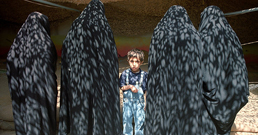A Photo Storyteller
3.11.2011
Some 30 years after the revolution and 20 years after the war with Iraq, Iran is witnessing the rise of a new genre in photo-journalism rooted both in digital innovation and the ancient art of storytelling. I call these practitioners “the photo-story tellers”.
I became acquainted with Omid Salehi's photo-stories through Jadidonline. As a new form of digital art, photo-story is a delicately crafted embroidery of frozen moments with a narrative that is expected to adhere to the old rules of timeliness and objectivity.
Omid and other storytellers are seriously engaged in a detailed study of the lives of individuals in their interaction with the old and the new, and their search for self-fulfillment.
These young artists have been through slogans and dramas in the name of the revolution. Therefore, photography is not about political drama and heroism but about exorcising it, studying it as a subject objectively. Their narrative is about portraying life in its simplicity, whether ugly or beautiful, to tease out the complexity of its depth where simple ordinary people are put in a context, to show the complex social changes that Iranian society is going through.
This is a generation of people who want solace and spiritualism for their hearts and souls, but they want to choose it themselves. There is a mystique, a craftsmanship, as Hafiz would put it, in the way Iranians try to marry present with past, old and new, sacred and profane. They see religion, nationalism and traditional family loyalties more in the context of a supermarket, a bazaar; you choose what you need. The contrast or the contradiction in Omid's photo of women clad in black chadors visiting the tomb of Cyrus the Great at New Year’s poses an interesting question.
The narratives of photo-storytellers like Omid go deep into the social and psychological interactions of a dynamic society on the move; something that catchy political photos and headlines may not always convey.
In Omid Salehi’s latest collection of photographs published in London, we see a number of his photo stories about aspects of life that are having an impact on Iranian society. He puts the individual in the wider context and against the 'big (political) idea'. His photos portray the absurdity of the image within the image in the paradox of tradition and modernity; they illustrate the irony of real life versus a political agenda.
Perhaps the photo of a young man and woman drinking tea and smoking water-pipes in a traditional tea-house on Kish island in the Persian Gulf, sums it up: despite all impositions, we are individuals and we want to lead our lives the way we want.
This generation of Iranians may not have witnessed the revolution in its dramatic birth, but has felt and internalised its consequences and experienced life under its rule. That is why their pictorial narrative is seen as a search for a cultural and social alternative, and in political terms, for behavioural change, by ruler and ruled. All these signs indicate that Iran's path for renewal is continuing some 170 years after the birth of photography, and modernism is on the move to deconstruct the past.
In this multi-media report the prominent Iranian photographer Abbas of Magnum Photos agency evaluates Omid Salehi’s latest photo collection ‘A photographer’s
Journey through Iran’ edited by Rose Issa and published by Beyond Art Production.
Omid Salehi
A photographer's Journey through Iran
Edited by Rose Issa
London, Beyond Art Production, 2011


